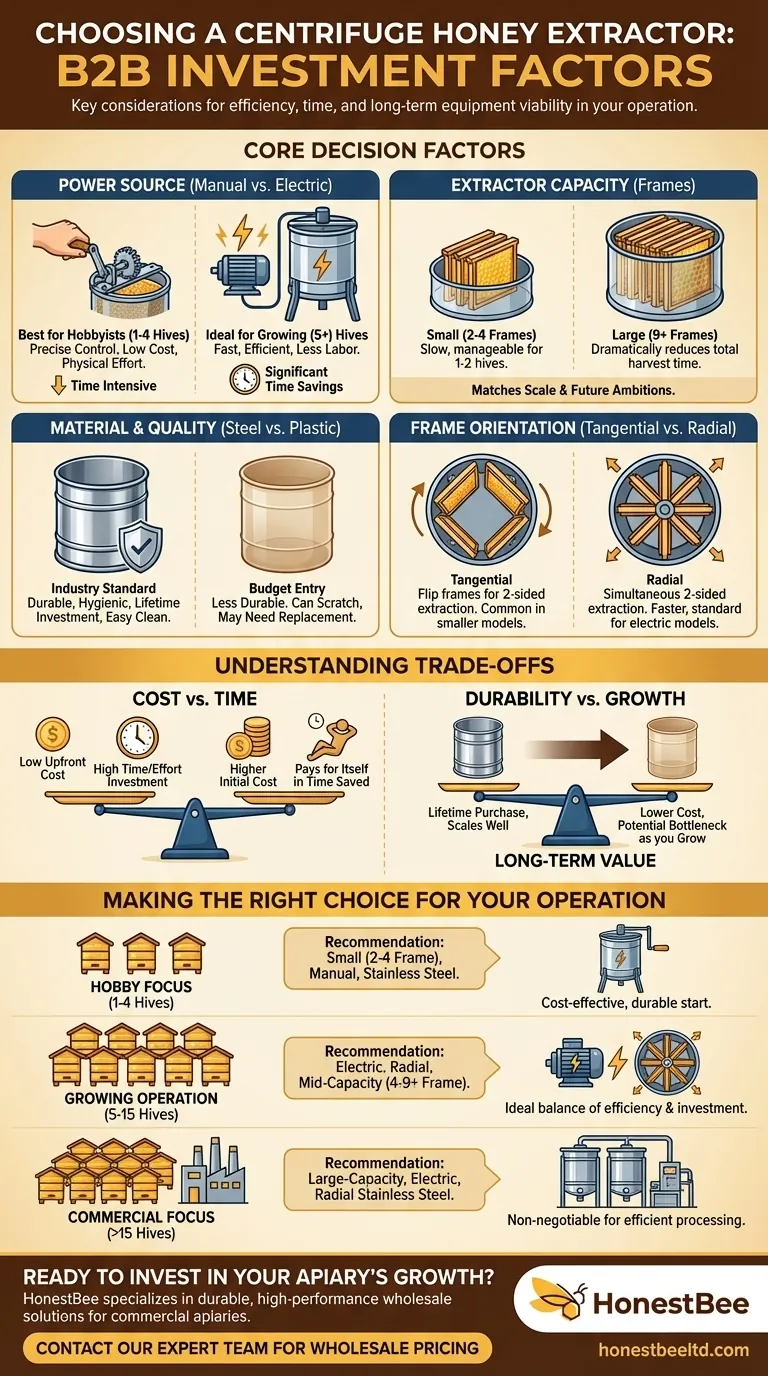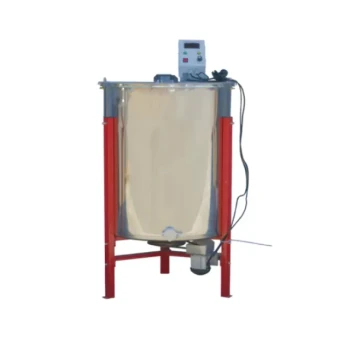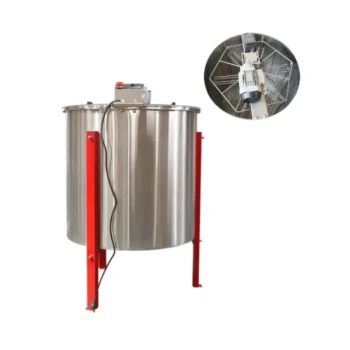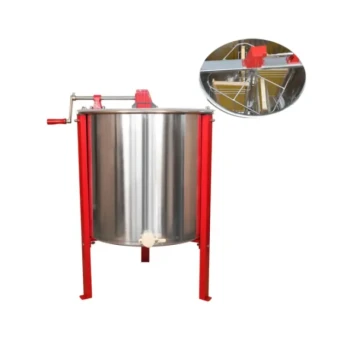The most critical factors in choosing a centrifuge honey extractor are the scale of your beekeeping operation, the extractor's power source (manual vs. electric), its material (stainless steel vs. plastic), and its capacity in frames. These choices directly impact the efficiency of your harvest, the time you spend, and the long-term viability of your equipment.
Your core challenge is not just buying an extractor, but investing in the right tool for your specific journey as a beekeeper. The ideal choice balances your current number of hives with your future ambitions, preventing you from buying a tool you'll quickly outgrow.

Core Decision Factors Explained
Choosing an extractor involves a few key variables. Understanding how each one affects your workflow is essential to making a sound investment.
Manual vs. Electric Power
The power source is the most significant decision, directly tied to the size of your apiary.
Manual extractors, operated by a hand crank, are best for small-scale hobbyists. They are less expensive and offer precise control over spinning speed, which is gentle on delicate comb.
Electric extractors use a motor to spin the frames, making them significantly faster and less labor-intensive. They are the clear choice for beekeepers with more than a few hives, saving hours of effort during harvest.
Extractor Capacity (Number of Frames)
Capacity determines how many frames of honey you can process in a single run. This is a simple calculation of efficiency.
A small capacity (2-4 frames) is suitable for a beekeeper with just one or two hives. The process will be slow but manageable.
A larger capacity (9+ frames) is necessary for anyone with a growing number of hives. Processing more frames at once dramatically reduces the total time spent on extraction.
Material and Build Quality
The material of the extractor drum and basket impacts durability, cleaning, and food safety.
Stainless steel is the industry standard. It is highly durable, will not rust, is easy to sanitize, and won't impart any flavor to the honey. This is a long-term investment.
Plastic extractors are a lower-cost entry point for beginners. While functional, they can be harder to clean, may scratch over time, and are less durable than their steel counterparts.
Frame Orientation: Radial vs. Tangential
This technical detail affects extraction efficiency.
Tangential extractors hold frames with one side facing outward, like pages in an open book. You must spin the frames, stop, flip them manually, and spin again to extract honey from both sides. This design is common in smaller, manual models.
Radial extractors hold frames like spokes on a wheel, with the top bar facing outward. Centrifugal force extracts honey from both sides simultaneously, making them much faster and eliminating the need to flip frames. This is standard for most electric models.
Understanding the Trade-offs
Every choice comes with a compromise. Being aware of these trade-offs ensures you make a decision without future regrets.
The Cost vs. Time Equation
A manual extractor has a low upfront cost but demands a significant investment of your time and physical effort during every harvest. An electric model costs more initially but pays for itself by turning a multi-day job into a single afternoon.
Durability and Long-Term Value
A high-quality stainless steel extractor can be a lifetime purchase. A plastic model, while affordable, may need to be replaced as your operation grows or if it cracks, ultimately costing more in the long run.
Planning for Future Growth
The most common mistake is buying an extractor that fits your needs today. If you plan to expand your apiary from two hives to ten in the next few years, the small manual extractor you buy now will quickly become a bottleneck.
Making the Right Choice for Your Operation
Select your equipment based on a realistic assessment of your current and future beekeeping goals.
- If your primary focus is a hobby with 1-4 hives: A small, 2-4 frame manual extractor made of stainless steel is a cost-effective and durable starting point.
- If your primary focus is a growing operation of 5-15 hives: An electric, radial extractor with a capacity for at least 4-9 frames is the ideal balance of efficiency and investment.
- If your primary focus is a serious sideline or commercial operation (>15 hives): A large-capacity, electric, radial stainless steel extractor is a non-negotiable tool for efficient processing.
Choosing the right extractor is an investment in the efficiency and enjoyment of your beekeeping.
Summary Table:
| Factor | Key Consideration | Best For |
|---|---|---|
| Power Source | Manual (affordable, gentle) vs. Electric (fast, efficient) | Hobbyists (1-4 hives) vs. Growing/Commercial operations (5+ hives) |
| Capacity | Number of frames processed per run (e.g., 2-4 vs. 9+) | Matches the scale of your current and future operation |
| Material | Stainless steel (durable, easy clean) vs. Plastic (budget entry) | Long-term value and food safety |
| Frame Orientation | Tangential (flip frames) vs. Radial (simultaneous extraction) | Efficiency and speed during harvest |
Ready to invest in the right honey extractor for your apiary's growth?
At HONESTBEE, we specialize in supplying durable, high-performance beekeeping equipment to commercial apiaries and distributors. Whether you're scaling from a few hives to a serious sideline or managing a large commercial operation, our wholesale-focused solutions ensure you get efficient, long-lasting equipment that pays for itself in time saved.
Let's discuss your specific needs and find the perfect extractor to maximize your harvest efficiency. Contact our expert team today for personalized recommendations and wholesale pricing!
Visual Guide

Related Products
- Electric 8 Frame Honey Spinner Extractor Equipment for Beekeeping
- 8-Frame Electric Self-Reversing Honey Extractor Spinner for Commercial Honey Extraction Equipment
- Professional 4 Frame Self Reversing Electric Honey Extractor for Beekeeping
- HONESTBEE 72 Frame Industrial Electric Honey Extractor for Beekeeping
- HONESTBEE 3-Frame Manual Acrylic Honey Extractor
People Also Ask
- What should be considered when harvesting honey from multiple hives? Scale Your Harvest Efficiently
- What are the differences between manual and electric honey extractors? A Beekeeper's Guide to Power, Speed & Cost
- Why is cleaning a honey extractor important in beekeeping? Protect Your Honey Quality & Equipment
- How long should you spin honey for? Master the Art of Efficient, Safe Extraction
- How long should you spin honey? Master the Art of Efficient, Damage-Free Extraction



















